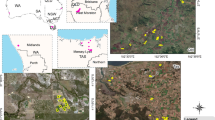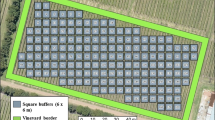Abstract
One of the main problems in the peanut production process is to identify the pod maturity stage. Peanut plants have indeterminate growth, which leads to a high pod maturity variability within the same plant. Moreover, the actual method of determining maturity is destructive and highly subjectivity, which does not represent the overall variability in the field. Hence, the main goal of this study was to verify the possibility to estimate peanut maturity and its in-field variability using an alternative non-destructive method based on orbital remote sensing. High-resolution satellite images (~ 3 m) were obtained from the PlanetScope platform for two commercial peanut fields in São Paulo state, Brazil, during the reproductive stage of the peanut crop (89 to 118 days after sowing—DAS). The fields were divided into 54 plots (30 × 30 m). The maturity was obtained using the Hull Scrape method. All Vegetation Indices (VIs) used showed a high Pearson correlation (p < 0.001) between peanut maturity and the VIs, with values decreasing as maturity increased. Non-Linear Index (NLI) values from 0.561 to 0.465 suggested that pods reached greater maturity than 74% (inflection point). The results found in this study indicated a great potential to use high-resolution satellite images to predict peanut maturity variability in commercial field. In addition, the proposed method contributes to monitoring the dynamics spatio-temporal of maturity progression, allowing for more accurate in-season and inversion management strategies in peanut.






Similar content being viewed by others
References
Abd-El Monsef, H., Smith, S. E., Rowland, D. L., & Abd El Rasol, N. (2019). Using multispectral imagery to extract a pure spectral canopy signature for predicting peanut maturity. Computers and Electronics in Agriculture, 162, 561–572. https://doi.org/10.1016/j.compag.2019.04.028.
Bindlish, E., Abbott, A.L., & Balota, M. (2017). Assessment of Peanut Pod Maturity, In: IEEE Winter Conference on Applications of Computer Vision, 688-–696. https://doi.org/10.1109/wacv.2017.82.
Boldor, D., Sanders, T., Swartzel, K., & Simunovic, J. (2002). Computer-assisted color classification of peanut pods. Peanut Science, 29(1), 41–46. https://doi.org/10.3146/pnut.29.1.0008.
Boote, K. J. (1982). Growth stages of peanut (Arachis hypogaea L.). Peanut Science, 9(1), 35–40.
Carley, D., Jordan, D., Dharmasri, L., Sutton, T., Brandenburg, R., & Burton, M. (2008). Peanut response to planting date and potential of canopy reflectance as an indicator of pod maturity. Agronomy Journal, 100(2), 376–380. https://doi.org/10.2134/agronj2006.0352.
Colvin, B., Rowland, D., Ferrell, J., & Faircloth, W. H. (2013). Development of a digital analysis system to evaluate peanut maturity. Peanut Science, 41(1), 8–16.
Conab—Companhia Nacional de Abastecimento. (2018). Acomp. safra bras. grãos, v. 8 Safra 2017/2018-Oitavo levantamento, Brasília, pp. 1–145 May, 2018. https://www.conab.gov.br/info-agro/safras/graos/boletim-da-safra-de-graos?start=30 Accessed 25 November 2020.
Conab-Companhia Nacional de Abastecimento. Acomp. safra bras. grãos 2012/13—Nono Levantamento–Jun/2013—Brasília: Conab, 2013 Available on: https://www.conab.gov.br/info-agro/safras/graos/boletim-da-safra-de-graos?start=90.
Feng, W., Wu, Y., He, L., Ren, X., Wang, Y., Hou, G., et al. (2019). An optimized non-linear vegetation index for estimating leaf area index in winter wheat. Precision Agriculture, 20, 1157–1176. https://doi.org/10.1007/s11119-019-09648-8.
Ghate, S., Evans, M., Kvien, C., & Rucker, K. (1993). Maturity detection in peanuts (Arachis hypogaea L.) using machine vision. Transactions of the ASAE, 36(6), 1941–1947. https://doi.org/10.13031/2013.28546.
Gitelson, A. A., & Merzlyak, M. N. (1996). Signature analysis of leaf reflectance spectra: Algorithm development for remote sensing of chlorophyll. Journal Plant Physiology, 148, 494–500.
Godoy, I. J., Santos, J. F., Carvalho, C. R. L., Michelotto, M. D., Bolonhezi, D., Freitas, R. S., et al. (2014). IAC OL3 e IAC OL4: new Brazilian peanut cultivars with the high oleic trait. Crop Breeding and Applied Biotechnology, 14, 200–203. https://doi.org/10.1590/1984-70332017v17n3c45.
Godoy, I. J., Santos, J. F., Michelotto, M. D., Moraes, A. R. A., Bolonhezi, D., Freitas, R. S., et al. (2017). IAC OL 5-New high oleic runner peanut cultivar. Crop Breeding and Applied Biotechnology, 17(3), 295–298. https://doi.org/10.1590/1984-70332017v17n3c45.
Goel, N. S., & Qin, W. (1994). Influences of canopy architecture on relationships between various vegetation indices and LAI and FPAR: A computer simulation. Remote Sensing Reviews, 10, 309–347. https://doi.org/10.1080/02757259409532252.
Gong, P., Pu, R., Biging, G. S., & Larrieu, M. R. (2003). Estimation of forest leaf area index using vegetation indices derived from hyperion hyperspectral data. IEEE Transactions on Geoscience and Remote Sensing, 41, 6. https://doi.org/10.1109/TGRS.2003.812910.
Houborg, R., & McCabe, M. (2016). High-resolution NDVI from planet’s constellation of earth observing nano-satellites: A new data source for precision agriculture. Remote Sensing, 8(9), 768. https://doi.org/10.3390/rs8090768.
Houborg, R., & McCabe, M. F. (2018). A cubesat enabled spatio-temporal enhancement method (CESTEM) utilizing planet, landsat and MODIS data. Remote Sensing of Environment, 209, 211–226. https://doi.org/10.1016/j.rse.2018.02.067.
Huete, A. R. (1988). A soil adjusted vegetation index (SAVI). Remote Sensing of Environment, 25, 295–309. https://doi.org/10.1016/0034-4257(88)90106-X.
**, X., Yang, G., Xu, X., Yang, H., Feng, H., Li, Z., et al. (2015). Combined multi-temporal optical and radar parameters for estimating LAI and biomass in winter wheat using HJ and radarsar-2 data. Remote Sensing, 7(10), 13251–13272. https://doi.org/10.3390/rs71013251.
Kyratzis, A. C., Skarlatos, D. P., Menexes, G. C., Vamvakousis, V. F., & Katsiotis, A. (2017). Assessment of vegetation indices derived by UAV imagery for durum wheat phenoty** under a water limited and heat stressed mediterranean environment. Frontiers in Plant Science., 8, 1114. https://doi.org/10.3389/fpls.2017.01114.
Li, R., Zhao, Z., Monfort, W. S., Johnsen, K., Zion, T. T., & Leo, D. J. (2020). Development of a smartphone-based peanut data logging system. Precision Agriculture. https://doi.org/10.1007/s11119-020-09758-8.
Planet. (2020). Planet Imagery Product Specification. https://assets.planet.com/marketing/PDF/Planet_Surface_Reflectance_Technical_White_Paper.pdf. Accessed 26 November 2020.
Planet Team. (2019). Planet Application Program Interface: In Space for Life on Earth. San Francisco, CA. https://api.planet.com Accessed 26 November 2020.
Robson, A., Phinn, S., & Wright, G. (2006). Using field spectroscopy and QuickBird imagery for the assessment of peanut crop maturity and aflatoxin risk. Journal of Spatial Science, 51(2), 151–162. https://doi.org/10.1080/14498596.2006.9635089.
Rouse, W., Haas H., Schell A., (1974). Deering W. Monitoring vegetation systems in the Great Plains with ERTS. In: Proc. Earth Res. Tech. Satellite-1 Symp., Goddard Space Flight Cent., Washington, DC., pp. 309–317.
Rowland, D. L., Sorensen, R. B., Butts, C. L., & Faircloth, W. H. (2006). Determination of maturity and degree day indices and their success in predicting peanut maturity. Peanut Science, 33, 125–136. https://doi.org/10.3146/0095-3679(2006)33%5b125:DOMADD%5d2.0.CO;2.
Rowland, D. L., Sorensen, R. B., Butts, C. L., Faircloth, W. H., & Sullivan, D. G. (2008). Canopy characteristics and their ability to predict peanut maturity. Peanut Science, 35(1), 43–54. https://doi.org/10.3146/PS06-052.1.
Rutkoski, J., Poland, J., Mondal, S., Autrique, E., Pérez, L. G., Crossa, J., et al. (2006). Canopy temperature and vegetation indices from high-throughput phenoty** improve accuracy of pedigree and genomic selection for grain yield in wheat. Bethesda, 6, 2799–2808. https://doi.org/10.1534/g3.116.032888.
Sadeh, Y., Zhu, X., Chenu, K., & Dunkerley, D. (2019). Sowing date detection at the field scale using CubeSats remote sensing. Computers and Electronics in Agriculture, 157, 568–580.
Sanders, T. H., Shubert, A. M., & Pattee, H. E. (1982). Maturity methodology and postharvest physiology. In H. E. Pattee & C. T. Young (Eds.), Peanut science and technology (pp. 625–627). Tifton, GA: American Peanut Research and Education Society.
Santos, A. F., Kazama, E. H., Ormond, A. T. S., Tavares, T. O., & Silva, R. P. (2016). Quality of mechanized peanut digging in function of the auto guidance. African Journal of Agricultural Research, 11(48), 4894–4901. https://doi.org/10.5897/AJAR2016.11442.
Santos, A. F., Lacerda, L. N., Gobbo, S., Tofannin, A., Silva, R. P., & Vellidis, G. (2019). Using remote sensing to map in-field variability of peanut maturity. In J. V. Stafford (Ed.), Precision Agriculture ’19, Proceedings of the 12th European Conference on Precision Agriculture (pp. 605–661). Wageningen, The Netherlands: Wageningen Academic Publishers. https://doi.org/10.3920/978-90-8686-888-9_75.
Santos, A. F., Silva, R. P., Zerbato, C., Menezes, P. C., Kazama, E. H., Paixao, C. S. S., et al. (2019b). Use of real-time extend GNSS for planting and inverting peanuts. Precision Agriculture, 20, 840–856. https://doi.org/10.1007/s11119-018-9616-z.
USDA-United States Department of Agriculture. (2020) https://apps.fas.usda.gov/psdonline/reportHandler.ashx?fileName=BVS&reportId=918&templateId=1&format=html Accessed 24 November 2020.
Wicaksono, P., & Lazuardi, W. (2018). Assessment of PlanetScope images for benthic habitat and seagrass species map** in a complex optically shallow water environment. International Journal of Remote Sensing, 39, 5739–5765. https://doi.org/10.1080/01431161.2018.1506951.
Williams, E. J., & Drexler, J. S. (1981). A non-destructive method for determining peanut pod maturity. Peanut Science, 8(2), 134–141. https://doi.org/10.3146/i0095-3679-8-2-15.
Zerbato, C., Furlani, C. E. A., Oliveira, M. F. D., Voltarelli, M. A., Tavares, T. O., & Carneiro, F. M. (2019). Quality of mechanical peanut sowing and digging using autopilot. Revista Brasileira de Engenharia Agrícola e Ambiental, 23(8), 630–637. https://doi.org/10.1590/1807-1929/agriambi.v23n8p630-637.
Acknowledgements
The authors are grateful to the São Paulo State University (UNESP), Jaboticabal Campus for the academic support and availability of laboratories, and the National Council for Scientific and Technological Development (CNPq) for the scholarship to the first author during his Ph.D. The authors are also thankful to Coplana Brazilian Premium Peanuts for providing assistance selecting the fields to conduct the trials and all their support for our team. Finally, we thank the PlanetLab team, in the person of Dr. Joseph Mascaro, who made the educational license available for the accomplishment of this work.
Author information
Authors and Affiliations
Corresponding author
Ethics declarations
Conflict of interest
The authors declare that they have no known competing financial interests or personal relationships that could have appeared to influence the work reported in this paper.
Additional information
Publisher's Note
Springer Nature remains neutral with regard to jurisdictional claims in published maps and institutional affiliations.
Rights and permissions
About this article
Cite this article
dos Santos, A.F., Corrêa, L.N., Lacerda, L.N. et al. High-resolution satellite image to predict peanut maturity variability in commercial fields. Precision Agric 22, 1464–1478 (2021). https://doi.org/10.1007/s11119-021-09791-1
Accepted:
Published:
Issue Date:
DOI: https://doi.org/10.1007/s11119-021-09791-1




